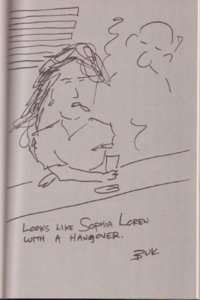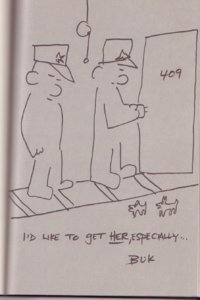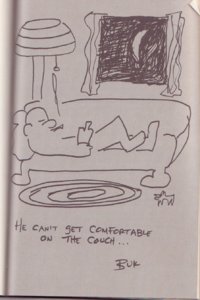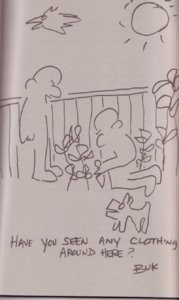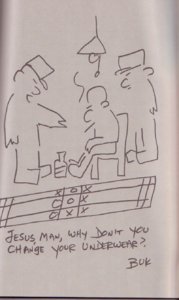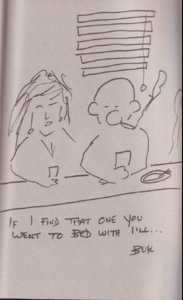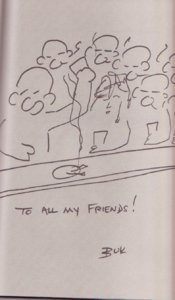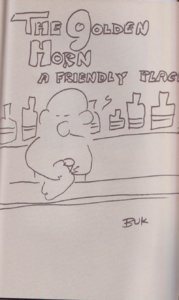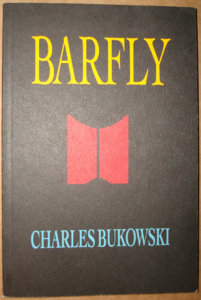You are using an out of date browser. It may not display this or other websites correctly.
You should upgrade or use an alternative browser.
You should upgrade or use an alternative browser.
Barfly (Paget Press edition) (2 Viewers)
- Thread starter mjp
- Start date
That is correct. It is a screenplay. The difference is that instead of a center section of stills from the movie, it has 20 line drawings by Bukowski that depict scenes from the film. Each drawing is captioned. For instance, "I'll drive ya right through the wall tonight, fag!", "You make me puke in my beer!", and "Jesus, man, why don't you change your underwear?" are a few of my favorites. There are 20 special copies that have an actual drawing from the book bound in.
Is that too much information?
Is that too much information?
i wonder if/how the script might differ too? i know the BSP edition has lines that weren't filmed or were cut from the finished film, but i don't know if Bukowski changed the script much between 1983 (?) and 1987.
I have been interested in different versions of the script that come up sometimes. I saw a real (not xeroxed) shooting script a few years ago, as issued to cast and crew. also, recently an early script from when James Woods was lined up for the Henry role (well thats what I read). not sure if the script was ever available with any other title, ie The Rats of Thirst.
Anyone here seen the Italian 1st edition? Or know the story of how it came to be published there first?
Here's a reletive tidbit, from a French site that seems to have vanished:
I have been interested in different versions of the script that come up sometimes. I saw a real (not xeroxed) shooting script a few years ago, as issued to cast and crew. also, recently an early script from when James Woods was lined up for the Henry role (well thats what I read). not sure if the script was ever available with any other title, ie The Rats of Thirst.
Anyone here seen the Italian 1st edition? Or know the story of how it came to be published there first?
Here's a reletive tidbit, from a French site that seems to have vanished:
April 23, 1979
Hello editors of NOMADES :
I received your letter of Jan.14, this year, asking for something I have written. I remember Paris with mixed memories but I haven't forgotten your request. I've been busy writing a screenplay which Barbet-Schroeder will direct. It took me a good 3 months and it's tentatively called THE RATS OF THIRST and I guess it will turn into celluloid when we find a half a million dollars in the alleys (as you can see I am a shitty typist and I've even sober as I type this.) Anyhow, here are a few poems I have written this week for you to look over. If your magazine is in existence and you wish to print them, don't let anything stop you. But if the poems don't work for you, please return them and I'll try them somewhere here in the U.S. Oh yes, if they do come out there, please ship me a couple of copies of your magazine.
By the way, in the poem " the E was all right ", the reference to " Gypsy " in the poem relates to one Gypsy Lou Webb, wife of the deceased once great American editor Jon Lou Webb who published the magazine THE OUTSIDER and some of my very early books of poetry. They were both quite strange and magic people, and Gypsy is still alive, and I am too, mostly, and so here are the poems...
Charles Bukowski
copyright Francis Juif & Br?ves
mjp
Founding member
No such thing.nymark said:Is that too much information?
All film scripts are Xeroxed, at least they were up through the mid 90's, I haven't been around the business since then.hank solo said:I saw a real (not xeroxed) shooting script a few years ago, as issued to cast and crew.
It would be easy to tell an actual used script though, because it would be all fucked up. The perfect examples you see are reproductions, but if you're just looking for the words, that's fine.
well, i guess the actual script was xeroxed, but the cover was different to some i've seen.
i've seen xeroxed scripts where the whole thing is a xerox on normal copier paper.
but this one i described as "real" had a card cover (i think it was blue) with cannon films stamped across it. it just looked completely authentic, if pretty much mint.
anyway, what i'd be interested in is just any variation in the script itself, as i've only read the BSP one.
:p
i've seen xeroxed scripts where the whole thing is a xerox on normal copier paper.
but this one i described as "real" had a card cover (i think it was blue) with cannon films stamped across it. it just looked completely authentic, if pretty much mint.
anyway, what i'd be interested in is just any variation in the script itself, as i've only read the BSP one.
:p
chronic
old and in the way
mjp said:Anyone have the Paget Press edition of Barfly (rhetorical question - I know someone here has it)? Is it just the screenplay, like the Black Sparrow version?
It is "a" screenplay but has substantial differences from "The Movie: Barfly." Much of the dialogue was rewritten but the structure and story line are pretty much the same.
Pogue Mahone
Officials say drugs may have played a part
I read the original script over the weekend. On an initial, un-scientific glance, I’d say 75% of the dialog is the same as the final version. Most of the changes take place in the second half of the script. There is at least one scene not included in the final, which is not significant. Probably most significant is that the last line of the original screenplay belonged to Tully, where she yells “BARFLY” in disgust. (Glad that was removed.)
All in all, I think it’s worth reading. Some of the original screenplay seems a little more natural (less dramatic), but it all evens out in the end. If nothing else, it’s worth having for the drawings, which I’ll post in case you don’t have the scratch to get a copy.
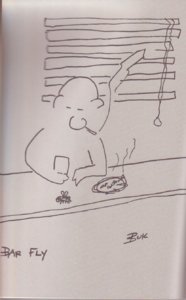
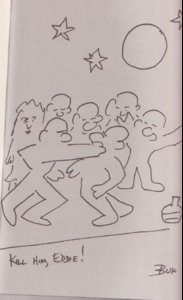
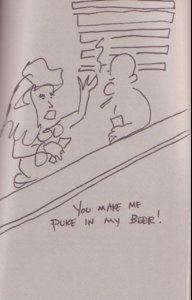

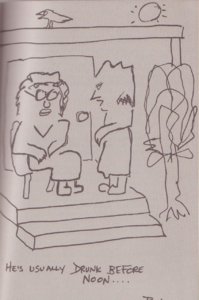
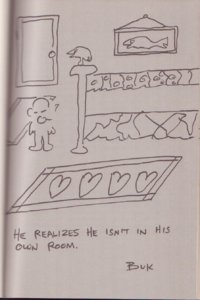
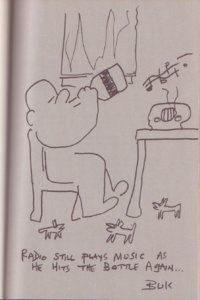
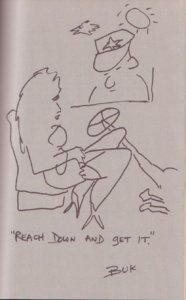
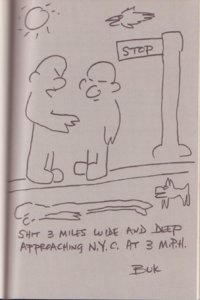
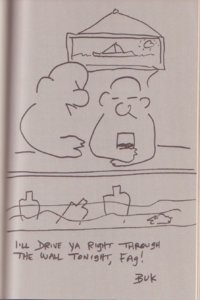
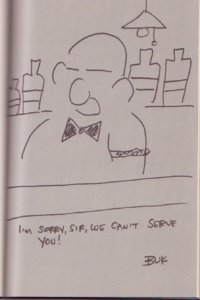
All in all, I think it’s worth reading. Some of the original screenplay seems a little more natural (less dramatic), but it all evens out in the end. If nothing else, it’s worth having for the drawings, which I’ll post in case you don’t have the scratch to get a copy.











Pogue Mahone
Officials say drugs may have played a part
They are in both the wraps and HC versions of Barfly (Paget Press, 1984). They are not part of any copy of The Movie: "Barfly" (BSP, 1987). Drawing #7 was also released as part of 5 Postcards.
...and Bukfan proves once again that he only sleeps when he needs to, which apparently isn't at night. :eek:
I picked up a very clean wraps copy of the Paget Barfly on ebay about three years ago for ~$20. And no, I don't want to sell it because the hardcover I have is a trade edition (yellow cloth spine) that is uncalled-for signed by Buk and Barbet Schroeder.
I picked up a very clean wraps copy of the Paget Barfly on ebay about three years ago for ~$20. And no, I don't want to sell it because the hardcover I have is a trade edition (yellow cloth spine) that is uncalled-for signed by Buk and Barbet Schroeder.
Last edited:
The Paget Press version was published in December 1984 and the BSP version was published in September 1987. So, lots of time in between for changes and the trials and tribulations of pulling together a film as documented in Hollywood. And keep in mind that L'ubriacone was published in Milan in September 1983, a full four years before the BSP version. I've never seen a copy of L'ubriacone, nor do I read Italian, but one might assume that the content was similar to that in the Paget Press version.
Pogue Mahone
Officials say drugs may have played a part
The other thing about the Paget press edition is there is much, much, much less discriptive text (whatever you call that in a screenplay) which I found distracting in the Black Sparrow edition. Having said that, it's clear from his drawings (and the discriptive text in the original) that Buk did have a vision of how it should look. Most importantly the opening and closing shots -- camera walking into the bar and then pulling back out at the end. Personally, that's my favorite thing about how the movie was shot -- barfly bookends.
And here's why:The other thing about the Paget press edition is there is much, much, much less descriptive text (whatever you call that in a screenplay) which I found distracting in the Black Sparrow edition.
emphasis in bold is mineThe Movie: "Barfly" (1987) - Publisher's Note said:Charles Bukowski wrote the screenplay of Barfly at the invitation of the director, Barbet Schroeder. (The original written version was published in Toronto by Paget Press in 1984.) As is usual in the course of making a film, this script underwent many changes as Bukowski and Schroeder worked on the production -- both additions (of dialogue, scene and camera directions, etc.) and excisions. What we published here is the script of the finished film, with some of the purely technical directions removed and with most of the excised portions of the original version of the script restored when their interest as reading material warranted it. These restorations have been placed between square brackets.
Last edited:
Pogue Mahone
Officials say drugs may have played a part
75% was just a guess. The one scene missing that I referenced is Henry looking for Wanda's clothes the next morning after he threw them out the window. He's asking a guy working in a garden if he's seen them. This is one of the drawings I posted. The guy put the clothes in a box to give them to the Salvation Army. He gives Henry the box of clothes back, Henry goes back upstairs and attempts to hang them back up. Then just to prove what an asshole he is, he throws the box out the window to the old man working his garden.
In the movie, this was much shorter. Wanda calls him up and asks if he wants to see her. Henry says yes and runs down the stairs to get her clothes before she gets there.
When Wanda shows up and sees her clothes all fucked up, Henry says he was looking for a lottery ticket...
My guess is that this really happened with Joan, but it was too slow a scene for a movie. The scene they did include was pretty good. We've all seen it.
Here's the weirdest change between the original and the Black Sparrow: In the original, Wanda's room is on the 3rd foor. In the final her room is on the 4th. Same room number (308 and 408), but different floors. Anyone got a guess as to why?
And it is not a small reference. Because each time he has to call the welfare ambulance service, he gives them the room number. And in the scene where they steal the green corn, Henry tells her to hold the elevator button (3rd and later 4th) because the cops won't be able to do anything.
In the movie, this was much shorter. Wanda calls him up and asks if he wants to see her. Henry says yes and runs down the stairs to get her clothes before she gets there.
When Wanda shows up and sees her clothes all fucked up, Henry says he was looking for a lottery ticket...
My guess is that this really happened with Joan, but it was too slow a scene for a movie. The scene they did include was pretty good. We've all seen it.
Here's the weirdest change between the original and the Black Sparrow: In the original, Wanda's room is on the 3rd foor. In the final her room is on the 4th. Same room number (308 and 408), but different floors. Anyone got a guess as to why?
And it is not a small reference. Because each time he has to call the welfare ambulance service, he gives them the room number. And in the scene where they steal the green corn, Henry tells her to hold the elevator button (3rd and later 4th) because the cops won't be able to do anything.
Bukfan
"The law is wrong; I am right"
Yes, the 75% was just a guess, but since you´ve read both versions of the script i´m sure it was an educated guess.
As for the clothes scene, they probably decided it was´nt good enough for an extended scene so they shortened it.
I´m at a loss as to why they changed the floor and room number. It does´nt make much sense.
As for the clothes scene, they probably decided it was´nt good enough for an extended scene so they shortened it.
I´m at a loss as to why they changed the floor and room number. It does´nt make much sense.
Pogue Mahone
Officials say drugs may have played a part
Maybe Martin changed the floor. As I recall from Buk's letter about the first edition of Women, Martin changed a woman's dress from green to blue (please fact check colors). And Buk was at a complete loss to explain that one. The rest of the changes were bad enough. But if you have read the old stuff enough, Buk had a thing for green clothing and women, so it's no wonder he caught it. It may have pissed him off more than the changes to the original dialogue (Sorry, my spelling sukz).
Or maybe Buk just remembered he lived on 3 instead of 4. Supposedly (and I don't necessarily believe it), during the shooting he realized he and Jane had actually lived for a time in that building above the bar.
Or maybe Buk just remembered he lived on 3 instead of 4. Supposedly (and I don't necessarily believe it), during the shooting he realized he and Jane had actually lived for a time in that building above the bar.
just a wild guess: when he was writing the screenplay in the first place, he obviously didn't have a special shooting-location in mind. After they've found the building, where they shot the scene, the story of the room appeared to be different, so they changed it in the screenplay.[...] In the original, Wanda's room is on the 3rd foor. In the final her room is on the 4th. [...]
PhillyDave
“The essential doesn't change.” Beckett
Never saw this first edition of Barfly in person until this past Sunday. Reconnecting with some old friends we gathered at someone's home I'd never been to before. Scanning the bookshelves I discovered their excellent collection of Buk. They have only BSP editions and City Lights, all editions from before he died and nothing from post-death Martinized horrors. The sad part about their copy of Barfly is that although it's a first edition it's from an old library copy so there's a bar-code type sticker inside as well as the front & back cover torn off. Ouch. I wept inside. Still though, isn't it great to discover Buk readers, especially those that "get it"?
PhillyDave
“The essential doesn't change.” Beckett
It would be pretty cool if the Paget edition got re-released just so we could get a close look, in our hands, and see the comparisons.
Similar threads
Users who are viewing this thread
Total: 3 (members: 0, guests: 3)

